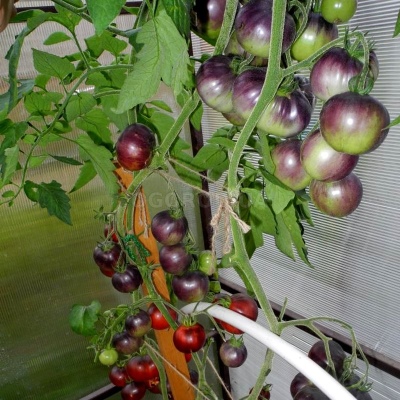
- Authors: R. Dukhov (Ukraine)
- Appeared when crossing: Bleve P-20 x Black Pear
- Name synonyms: Blue Pear, Blue Pear Duhova
- Category: grade
- Growth type: indeterminate
- Appointment: universal
- Ripening period: mid-season
- Ripening time, days: 110
- Growing conditions: for open ground, for greenhouses
- Bush size: tall
The unusual appearance of some pear-shaped tomatoes is enhanced by a non-trivial color: yellow, orange, emerald. Not so long ago, the exotic Blue Pear was added to the family of pear tomatoes.
Breeding history
The variety was bred in 2015 by the Ukrainian breeder Ruslan Dukhov. On account of this still very young man, there are already several dozen copyright varieties. As a teenager Ruslan began to collect a unique collection of seeds from all over the world. Today Semyon Dukhovykh is a successful family business that sells selected seed material of various crops.
The Blue Pear variety was obtained by crossing the Black Pear and Bleve P-20 subspecies (USA). A beautiful, tasty and unpretentious variety quickly spread in Ukraine, Europe and Russia.
Description of the variety
Blue pear is a mid-ripening, productive, disease-resistant and hot-weather variety for open ground and greenhouses, forming tall (up to 2 m) bushes with sparse foliage. Dessert-flavored tomatoes have a flattened pear-shaped shape and slight ribbing.
The main qualities of the fruit
Anthocyanin, a pigment rich in many berries: blueberries, blackberries, as well as vegetables such as eggplant and red cabbage, is responsible for the amazing purple-blue hue near the petiole. Regular consumption of foods with a high concentration of these glycosides has a bactericidal, antioxidant and vascular wall strengthening effect on the human body.
Blue pear tomatoes often have an interesting double color: first, light green with a dark "crown", and then red-brown with an ink stain of anthocyanin, spreading down from the stalk. The shape of the tomatoes is not too elongated, rather, it is flattened and wide at the bottom. Ribs extend from the cutting, and in most cases they are shallow.
Fruits have a wide variation in size and weight: up to 10 cm in diameter and from 120 to 200 g. Average weight - 150 g. The skin of tomatoes is glossy, soft, elastic, does not crack. The pulp on the cut will be without voids, it is fleshy, oily and juicy, rich red-cherry color, with small seed chambers (7-10 pieces).
Taste characteristics
Consumers rate the delicious taste of Blue Pear very highly: it is balanced, with a predominance of sugars and a spicy aftertaste. Tomatoes are used for salads and fresh consumption. The variety is perfect for making sun-dried tomatoes, sauces and mashed soups, for lecho and vegetable caviar. Small tomatoes are also suitable for canning.
Ripening and fruiting
This mid-season variety can be harvested approximately 110 days after sowing for seedlings. In the first days of July, ripe tomatoes are already on the bushes, and the highest yield occurs in the second half of the month. Tomatoes ripened on the bush will have the best taste. The fruiting season lasts until early October.
Yield
The variety is fruitful, more than 6 clusters are formed on the stem, and 5-6 ovaries ripen on one fruit cluster.Almost all small yellow self-pollinated flowers are tied, do not fall off. Each bush brings 3-4.5 kg of tomatoes. From an area of 1 m², from 15 to 18 kg can be harvested per season. Stable high fruiting is ensured in a greenhouse.
The timing of planting seedlings and planting in the ground
Work with seed is carried out in early March. You can sow seeds into peat tablets, a common container (picking will be required later) or separate containers. Two months later, in May, the seedlings are transferred to the site.

Growing tomato seedlings is an extremely important process, because it largely depends on whether the gardener can harvest at all. All aspects must be taken into account, from seedbed preparation to planting in the ground.
Landing scheme
Blue pear bushes are characterized by a compact root system, therefore, on a plot of 1 m², 3-4 plants are placed in a checkerboard pattern according to a scheme of 50x50 cm or 50x60 cm per seedling.

Growing and care
The agrotechnology of an indeterminate plant includes the obligatory garter to the support and pinching. It is better to form it in 2-3 shoots, but sometimes the bush is led into 1 stem 160-180 cm high.
Other care activities:
- top dressing (alternate mineral fertilizers and organic matter);
- loosening and mulching the soil;
- evening watering (about 7 liters under a bush 2 times a week);
- treatment with drugs for pests and infections.
The variety can withstand temperature extremes and summer heat.




A plant needs different micronutrients at each stage of growth. All fertilizers can be divided into two groups: mineral and organic. Folk remedies are often used: iodine, yeast, bird droppings, eggshells.
It is important to observe the rate and period of feeding. This also applies to folk remedies and organic fertilizers.
Disease and pest resistance
Blue pear has good immunity, but with excessive soil moisture it can be affected by late blight. Spraying will help from the onslaught of aphids and spider mites.



























































































